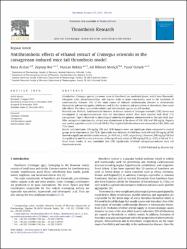Antithrombotic effects of ethanol extract of Crataegus orientalis in the carrageenan-induced mice tail thrombosis model
Özet
Introduction: Crataegus species (common name is Hawthorn) are medicinal plants, which have flavonoids, triterpene acids, proanthocyanidins, and organic acids as main constituents, used in the treatment of cardiovascular diseases. One of the main causes of multiple cardiovascular diseases is intravascular thrombosis and current agents, which are used for the treatment and prevention of thrombosis, have some side effects. Therefore, new antithrombotic and thrombolytic agents are still needed. Materials and Methods: Antithrombotic function of ethanol extract of Crataegus orientalis (COE) leaves was investigated in carrageenan-induced mice tail thrombosis model. Mice were injected with 40 mu l (1%) carrageenan (Type I) dissolved in physiological saline by intraplantar administration in the right hind paw. After carrageenan injection, the extract was administered at the doses of 100, 200, and 300 mg/kg. Heparin was used as a positive control (10 and 100 IU). The length of tail-thrombosis was measured at 24th, 48th, and 72nd hours. Results and Conclusion: 100 mg/kg COE and 10 IU heparin were not significant when compared to control groups at the time interval (24-72 h) that results was obtained. At 24th hour, both 200 and 300 mg/kg of COE showed a significant antithrombotic activity (p<0.05 and p<0.01, respectively). However, 200 mg/kg COE lost its significance and there was a decrease in the significance values of 300 mg/kg COE (p<0.05) at 48 and 72 h. From these results, it was concluded that COE significantly inhibited carrageenan-induced mice tail thrombosis in vivo.


















